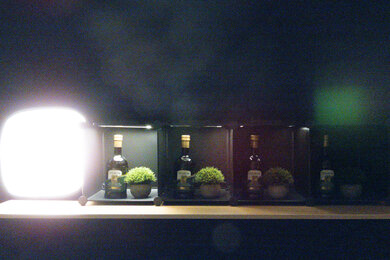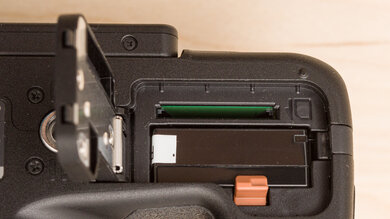The Canon PowerShot SX70 HS is a bridge camera with a built-in zoom lens. It has an incredibly long focal length, letting you capture everything from wide-angle landscapes to far-away subjects and close-ups. Despite its zoom lens, the camera feels lightweight and comfortable to use, with a simple menu system and decently sturdy construction. However, it's bulky in size, so it's not as convenient to take on the go. It also lacks a touchscreen, although the screen is fully articulated. The image quality is adequate. That said, sharpness declines significantly, and visual noise becomes noticeable at moderate to higher ISO levels, so it's not well-suited to low-light photography. On the upside, it has a decent autofocus system for photos, especially for slower or still subjects. Video quality and features are lacking, though, especially when it comes to low-light performance and autofocus.
Our Verdict
The Canon PowerShot SX70 HS is okay for travel photography. It's not especially portable, but it's relatively lightweight and feels comfortable to use. It has a fully articulated screen that gets bright enough to overcome glare, but unfortunately, it's not a touchscreen, making it harder to navigate the menu. That said, the menu is clean and simple. Autofocus performance is decent, and images look okay for the most part. However, the camera doesn't perform well in low light, as sharpness declines significantly at higher ISO levels. It also has a sub-par battery life, although this depends on settings and usage habits.
-
Lightweight and comfortable to use.
-
Fully articulated screen.
-
Simple menu system.
-
Image quality degrades in low light.
-
No touchscreen.
-
Bulky size.
The Canon SX70 HS isn't well-suited for landscape photography. It delivers reasonable image quality for a bridge cam, although it doesn't perform well in low light, as higher ISO levels introduce noticeable noise and a significant decline in sharpness. Its dynamic range is also very limited, so you'll lose some detail in high-contrast scenes. Unfortunately, it has a bulky design that makes it a little more cumbersome to take to remote shooting locations. It also lacks weather-sealing, so it won't be protected from rain or humidity if you shoot outdoors.
-
Lightweight and comfortable to use.
-
Fully articulated screen.
-
Simple menu system.
-
Image quality degrades in low light.
-
No touchscreen.
-
Bulky size.
-
Poor dynamic range.
The Canon PowerShot SX70 HS is okay for birding but isn't the best option for action photography. It has a good continuous shooting speed and a relatively quick buffer empty time, meaning you can capture moments of fast-moving action with minimal interruption. The built-in lens has an incredibly long focal length, great for capturing far-off subjects, and the optical stabilization does an excellent job of steadying the image, even at slower shutter speeds. You may still need a tripod when using the full focal length. Image quality is okay; that said, raising the ISO introduces significant noise and loss of detail and sharpness, so it isn't well-suited to shooting in dim lighting conditions. It also doesn't have an autofocus tracking function when shooting continuously.
-
Built-in lens has a very long focal length.
-
Lightweight and comfortable to use.
-
Excellent image stabilization.
-
Fairly quick burst shooting.
-
Image quality degrades in low light.
-
No touchscreen.
-
Bulky size.
The Canon SX70 HS has poor RAW photo performance. It has poor dynamic range, so the amount of shadow and highlight detail it can capture is limited. It's also best suited to very bright lighting conditions, as it doesn't manage noise very well in low light and has a limiting max ISO of 3200. You can still get good results with the right lighting conditions, and its overall image quality isn't too bad for its class.
-
Can get decent results in bright light.
-
Image quality degrades in low light.
-
Poor dynamic range.
The Canon PowerShot SX70 HS is adequate for vlogging. It's bulky, making it harder to shoot footage on the go, and the video quality is poor, especially in low light. While it does a good job of smoothing out camera shake in FHD, video stabilization performs much worse in 4k. Shooting in 4k also incurs a significant crop. Its autofocus system performs poorly for video as well. It has a fully articulated screen, so you can easily monitor yourself while recording.
-
Lightweight and comfortable to use.
-
Fully articulated screen.
-
Simple menu system.
-
Good video stabilization in FHD.
-
No touchscreen.
-
Poor video quality.
-
Can only shoot 4k video at 30 fps with a crop.
-
Disappointing autofocus performance.
-
Bulky size.
The Canon PowerShot SX70 HS is inadequate for studio video. Its video quality is poor, whether shooting in FHD or 4k, and its autofocus performance is disappointing. Its 4k capability is quite limited, as it can only shoot at 30 fps with a severe crop. Lastly, it's a bit limited in terms of inputs and outputs, as it lacks a headphone jack, and while it has a microphone jack, there's no hot shoe on which to mount an external mic. It also has an HDMI port, but it only allows for playback as opposed to external recording.
-
Lightweight and comfortable to use.
-
Fully articulated screen.
-
Simple menu system.
-
No touchscreen.
-
Poor video quality.
-
Inputs and outputs are limited.
-
Can only shoot 4k video at 30 fps with a crop.
-
Disappointing autofocus performance.
The Canon PowerShot SX70 HS isn't for action video. It's too bulky for mounting on an accessory or helmet, and it isn't weather-sealed. Video quality is also poor, especially in low light. While it does a great job of reducing camera shake in FHD, it struggles a bit in 4k. Finally, its frame rates are limited. It can't shoot in 120 or 240 fps, so you can't generate smooth slow-motion video, and when shooting in 4k, it's limited to 30 fps with a crop.
-
Great video stabilization in FHD.
-
Limited frame rates.
-
Not water-resistant.
-
Poor video quality.
-
Can only shoot 4k video at 30 fps with a crop.
-
Bulky size.
- 6.1 Travel Photography
- 5.7 Landscape Photography
- 6.6 Sport & Wildlife Photography
- 5.0 Raw Photo Performance
- 5.7 Vlogging
- 5.0 Studio Video
- 2.4 Action Video
Changelog
-
Updated Dec 18, 2024:
We added a link to the newly reviewed KODAK PIXPRO AZ528 in the Built-In Lens section.
- Updated Jan 29, 2024: Added text to the 'Raw Photo Performance' verdict box and updated other verdict boxes for accuracy and clarity.
- Updated Jan 29, 2024: Converted to Test Bench 0.12.1.
- Updated Apr 04, 2023: After reevaluating this camera's autofocus system, we've decided to set the 'Photo AF-C Tracking' box and score to N/A, since this camera doesn't have a true AF tracking feature in its continuous shooting mode.
- Updated Dec 14, 2022: Converted to Test Bench 0.12.
Check Price
Differences Between Sizes And Variants
The Canon PowerShot SX70 HS only comes in one color variant: 'Black'. You can see our unit's label here.
If you come across another variant or your SX70 HS doesn't correspond to our review, let us know, and we'll update the review.
Popular Cameras Comparisons
The Canon PowerShot SX70 HS and the Nikon COOLPIX P950 are both bridge cameras with long zoom ranges. However, the Nikon takes the cake for zoom with an 83x optical zoom range, as opposed to the 65x zoom on the Canon. Still, the Nikon is much bigger and heavier, making it less suitable for casual everyday or travel photography.
The Nikon COOLPIX P1000 and the Canon PowerShot SX70 HS are both superzoom or bridge cameras. At more than twice the price, the Nikon is certainly a bigger investment, but it also puts the "super" in "superzoom" in a way that puts the Canon to shame. It has a whopping 125x zoom range, compared to the Canon's 65x zoom. Of course, that also makes it a whole lot less portable. If you need that kind of zoom, the Nikon is the winner, but for more casual and everyday photography, go with the Canon.
The Sony RX10 IV is a better overall bridge camera than the Canon PowerShot SX70 HS. It has a larger, more powerful stacked sensor that delivers better image quality and allows for faster burst shooting. It's also better built, with more physical controls and weather-sealing, and it has a longer battery life and better autofocusing. That said, it's also a less portable camera and has a significantly shorter zoom range than the Canon.
The Canon PowerShot SX70 HS and the Panasonic LUMIX FZ80 are both solid bridge cameras. The Canon is a bit more premium, with a fully articulating screen and slightly better build quality. It also has a slightly longer zoom range, though the Panasonic isn't far off. On the other hand, the Panasonic has a more effective autofocus system. Its lens also opens up to a wider max aperture, giving you a tad more leeway in dimmer lighting conditions, though neither camera is very well-suited to low-light shooting. Still, for those reasons, the Panasonic camera offers a bit more value for its price.
Test Results
- Body is made of plastic
- Buttons feel nice and provide good tactile feedback
- Command dial feels solid and provides good feedback
- Additional zoom buttons on side of lens feel solid and work well
- Sturdy-feeling screen hinge
- Picture mode dial is somewhat stiff
- Battery/SD card compartment is covered by a locking hinged door, while inputs are covered by rubber flaps
- Grip is comfortable, but texture feels a bit lacking
- Only one command dial, but Q menu makes it easy to quickly adjust important settings
- Screen edge sticks out slightly when folded in
- Viewfinder includes a rubber eyecup and feels comfortable to use
- Exposure parameters are easy to adjust, even when looking through the viewfinder
- Fully articulated screen
- Lack of touchscreen makes it more difficult to navigate menu
- SD card can't be changed while the camera is mounted on a tripod
- Simple, uncluttered menu system
- Lack of touchscreen makes it a bit less easy to navigate
- Menu system changes depending on the current mode
- Quick menu makes it easy to access frequently-used settings
- Includes a guide mode, but it's limited to features found in the Q menu
If you're looking for a cheap bridge camera with an even longer zoom range, check out the KODAK PIXPRO AZ528.
Note: This camera may overheat and interrupt progress during long video recording sessions.
Note: The camera can only shoot in 4k resolution when set to 'Movie' mode. You can shoot video in other modes, like 'Manual' mode, but only in FHD. However, there's a 'Manual Video Mode' setting in the video menu that lets you adjust exposure parameters when shooting 4k video.
































































